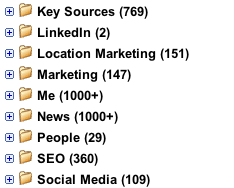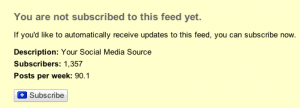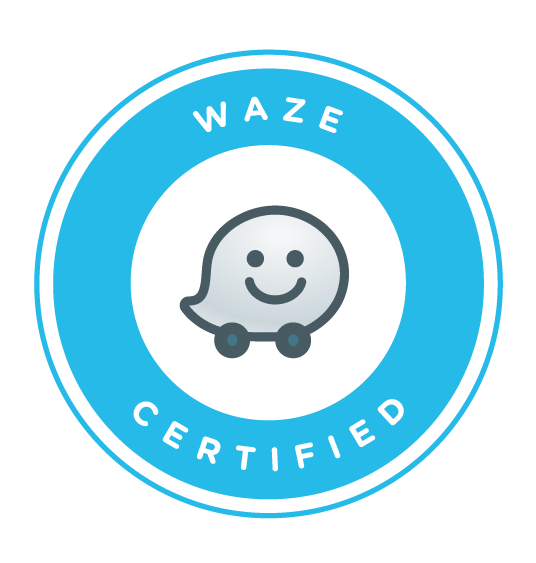This is the sixth in the series of “Practical Social Media”, looking in depth at how to set-up and run Social Media as part of your overall business strategy. If you have any areas you would like me to cover please let me know via the comments section below.
If there is one thing I love more than engaging with people online it’s sharing useful content with them via Social Media. It’s a good job too, as content curation plays a major part in developing social relationships.
As the expert in your field people will look to you for ideas and to advise them on the latest trends in your area of business. The only way you can hope to help them is by reading extensively, then sharing the relevant information that you find.
But first you have to find that content.
Staying up to date on your specialisation has never been easier. The Internet gives you instant access to the latest developments world-wide.
In popular subjects it can lead to information overload. Your job as an expert in your field is to act as a filter, dropping the rubbish, sharing prominent findings and eventually using this to develop your own content.
Content Curation Workflow
I am going to take you through a basic Content Curation Workflow that should provide you with enough content to manage each day without being onerous.
1. Content Repository
First we need somewhere to store the content ready for use. Using Google Reader we can automate much of the content collection, you can also access the content from any device that has an Internet connection.
So, set-up a Google Reader account if you don’t have one already.
Within Google Reader you should set up folders to hold your content. I would suggest a Blog, Twitter and People folders along with Subject Categories. This will allow you to do better filtering should you wish to narrow down your curation and focus in on a particular area at anytime.

reader folders
2. Populating Google Reader
Now we need to find content to fill these folders, first though I will show you how we populate a folder.
When you find a site that has content related to your subject matter and look for the RSS icon, like this one:

RSS Subscription Button
Ensure you are already logged into your Google Account and click on the RSS link, you’ll then be given the option to add the content to Google Reader:

Subscribe to Feed
Once you click the subscribe button then you can assign it to a folder.
3. Finding Content
Dependant on your speciality some of the suggested sources below may work better than others, but I’ll take you through several of my favourite sources.
8 places to look for content to curate:
a. Industry Leaders
These should be your first stop on the look out for content. You’ll want to add authority, trade body and association type sites, high level news or government information sites that may publish articles related to your industry.
b. Competitors
Make a list of every competitor you can think of, including international ones, even if you don’t trade internationally. Your looking for their news pages or blogs if they have them. Whilst your there, make sure you sign up to their email newsletters too, you can never have enough inside information.
c. Key Influencers
Earlier in the series we looked at finding Key Influencers in your market. Now you want to revisit those and subscribe to their blogs and emails.
d. Related Industries
What non-competing industries are related to your sector? Identify the key players in these sectors and add them to your news sources in Google Reader.
e. Twitter Feeds
You can actually subscribe to specific Twitter feeds which is a good way to capture mentions of your company, products or other keywords or phrases related to what you do that are mentioned on Twitter. It’s also a useful way to archive that information, something you can’t do on Twitter itself.
f. Google Alerts
How often do you search Google for information related to your industry. Well rather than continually searching you can have Google do it for you with Google Alerts. Search for a keyword or phrase in Google Blog Search, you can then feed those alerts into Google Reader to read and share when you want.

Google Alerts
g. News Aggregators
Although you will pick up the majority of sites and potential news from the previous methods, news aggregators can help pick up on any other sources. Look for categories related to your sector on sites like Digg, Reddit and All-Top. Larger publications like the BBC, CNN, Reuters, New York Times or Harvard Business Review may have specific categories that you may wish to monitor.
h. Industry Publications
Most paper based publications now have related web sites that contain all or some of the physical articles they publish. Add any relevant ones to your Google Reader.
You may come across some sites that do not have an RSS feed that you can subscribe to. In this case look for their email newsletter sign-up and subscribe to this instead. I would advise using a dedicated email address for this to keep it separate from your main email account; using a dedicated Gmail account is one option.
4. Sharing Content
Now all you need to do is, each day log into Google Reader and skim through the article headlines. Open and read anything of interest, please ensure you read it so you do not share something inappropriate or off topic. Once you are happy the article is relevant then just share the URL, using either the article title or an appropriate comment, on the platform of your choice.
In the next episode of Practical Social Media we’ll take a deeper look at sharing the curated content and ways you can speed the process up to save time and make it more effective. If you have any additional sources I should add to the list above please let me know in the comments below.






